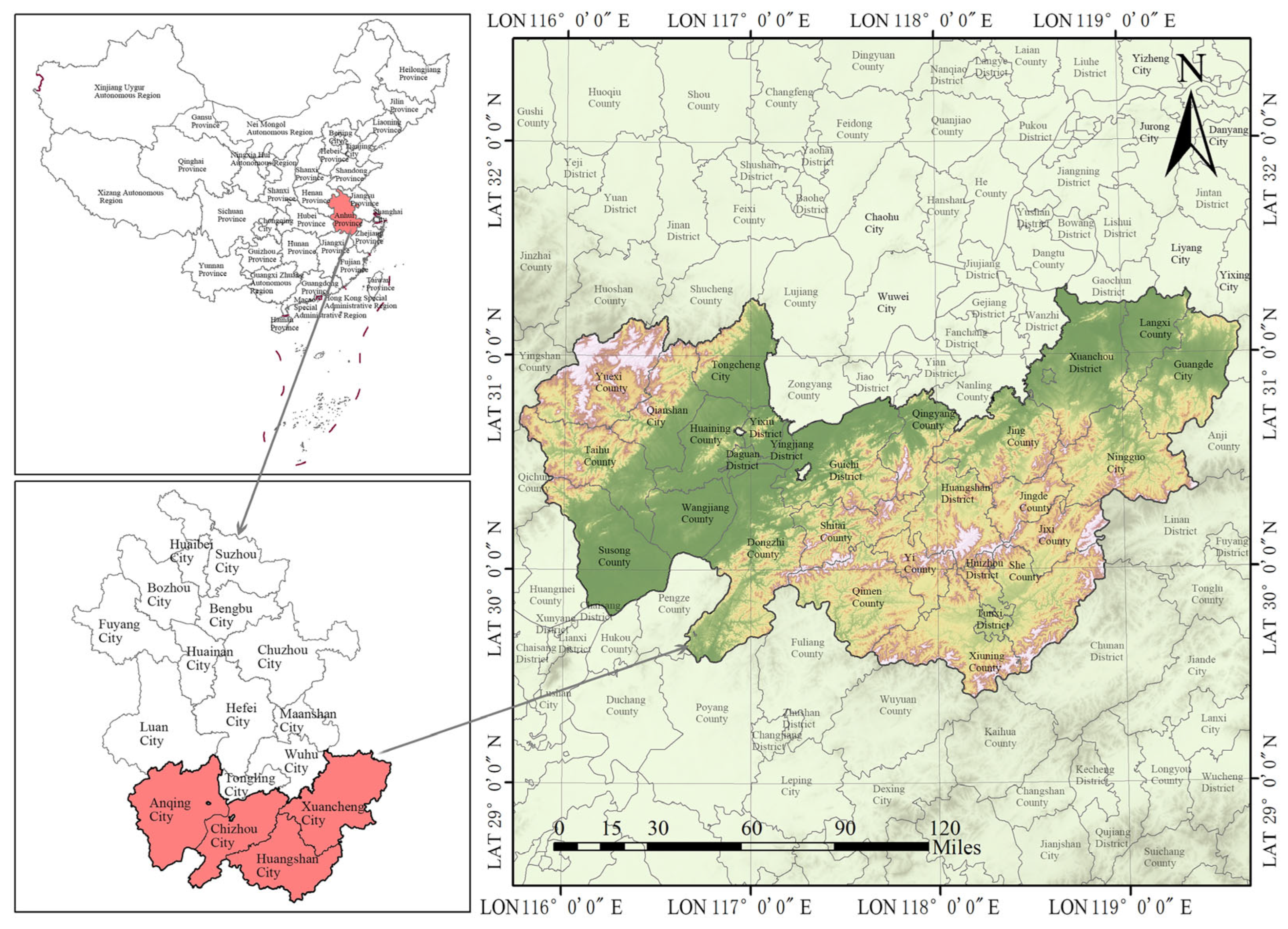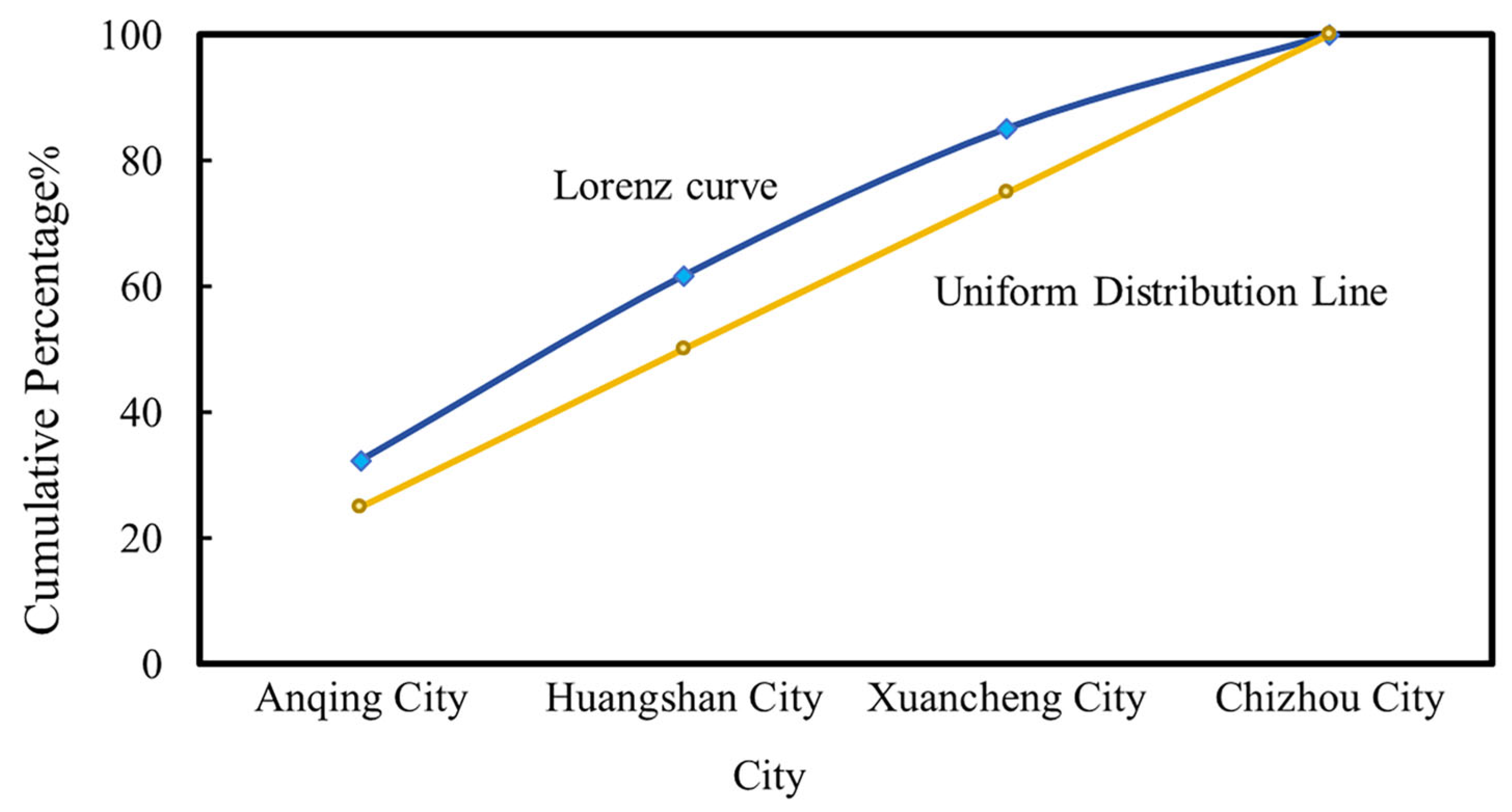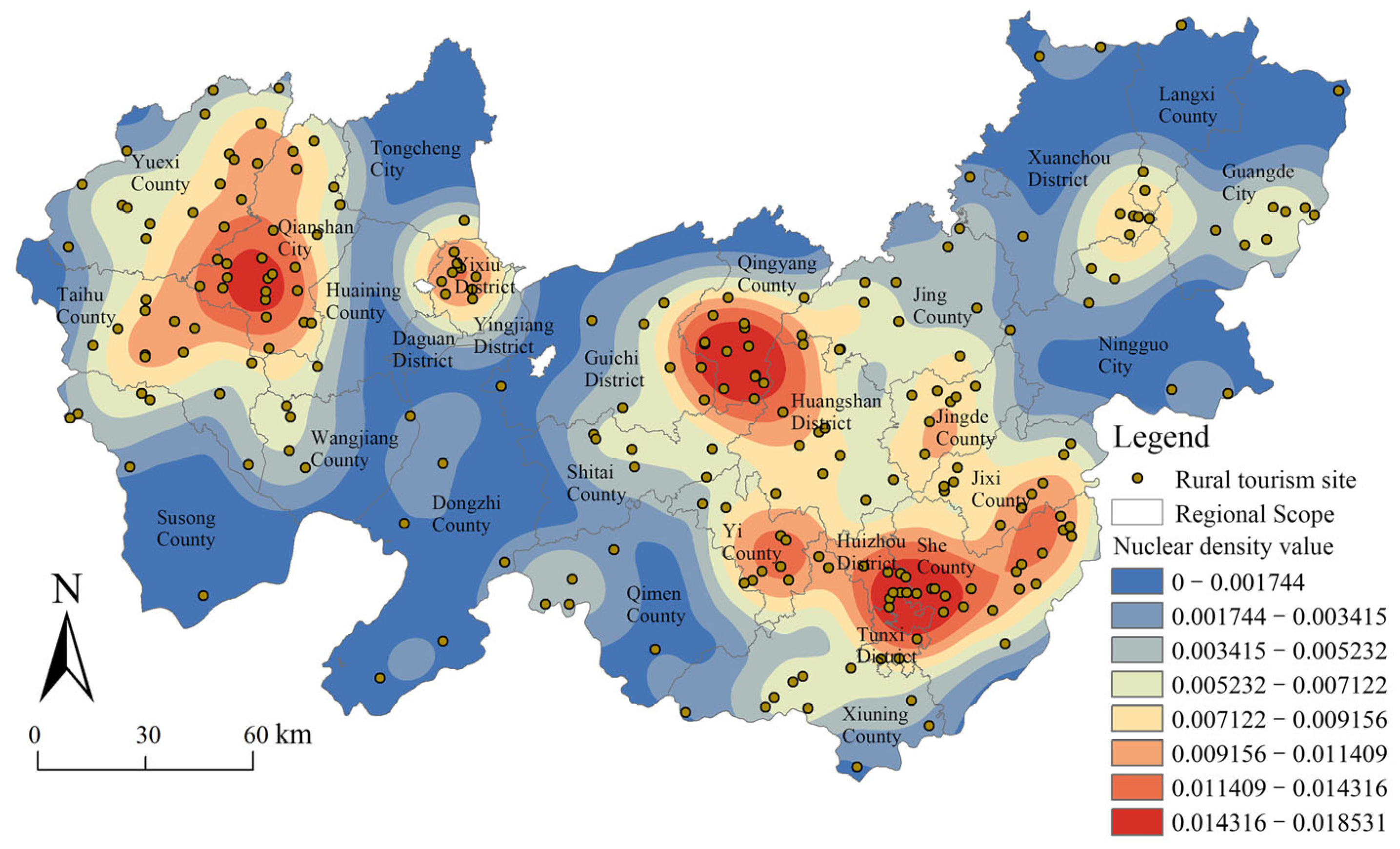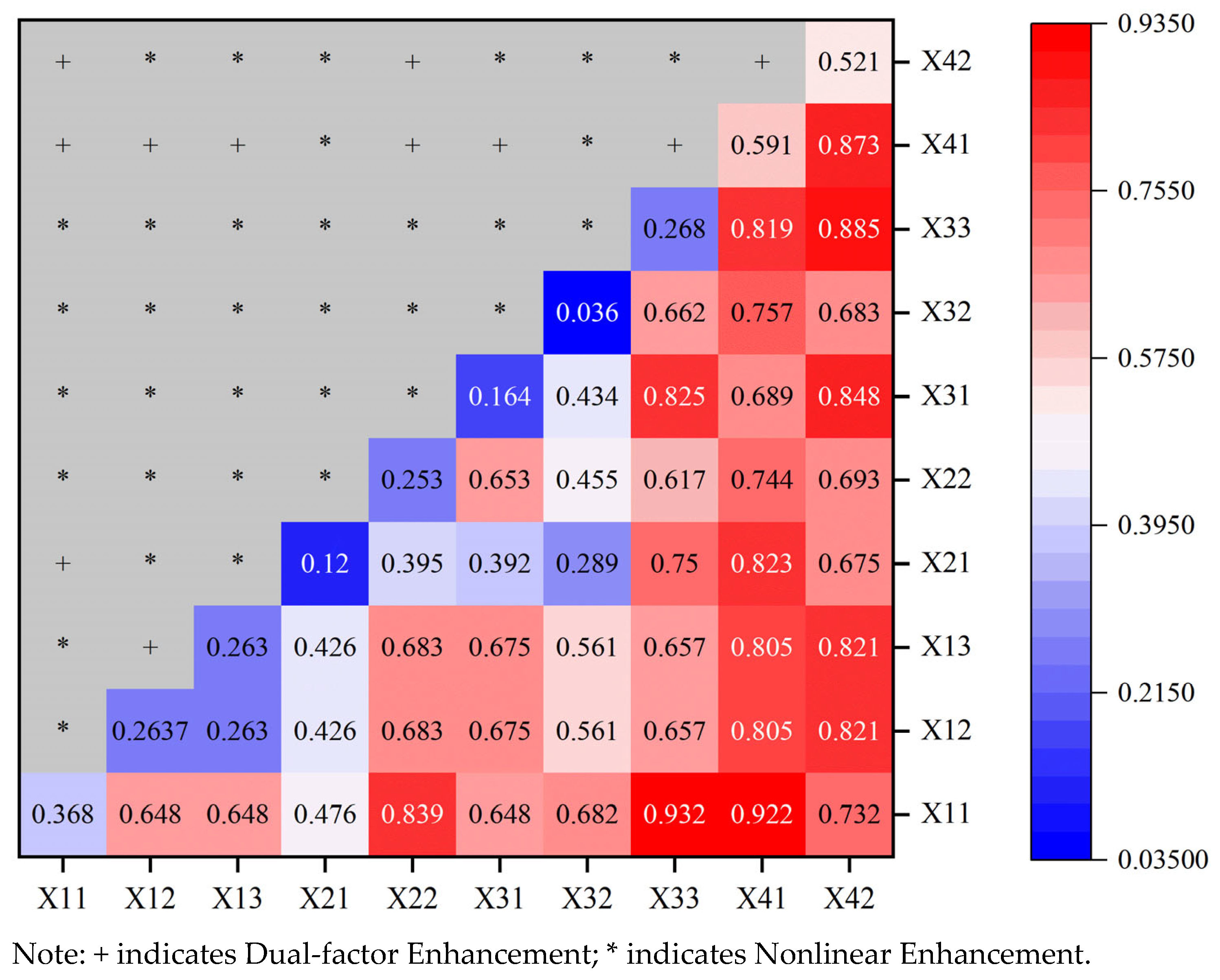3.2.2. Analysis of Differences in Factors Affecting GWR
The Geographically Weighted Regression (GWR) model was constructed to further examine regional differences in the effects of influencing factors in the Great Mount Huang area. First, an OLS linear regression analysis was conducted on the data. Diagnostic results indicated that the variance inflation factors (VIF) for all influencing variables ranged from 1.40 to 3.01, with all values below 7.5, suggesting no significant multicollinearity and confirming the feasibility of constructing a GWR model. Using MGWR 2.2 software, a GWR model was developed with standardized data, employing a fixed Gaussian kernel function, golden search bandwidth, and a projected coordinate system. The GWR model yielded an AICc value of 72.666, representing a reduction of 83.996 compared to the OLS model (
Table 6), indicating superior balance between model fit and parameter complexity, effectively avoiding overfitting while enhancing prediction accuracy and stability. Although the adjusted R
2 of the GWR model is 0.037 lower than that of the OLS model, this difference is within an acceptable range and does not substantially compromise the model’s explanatory power. Therefore, the GWR model is deemed more suitable than the OLS model. Spatial autocorrelation analysis of the standardized residuals using Moran’s I index produced a value of −0.0947, indicating a random spatial distribution and further validating the model’s effectiveness [
50].
Through the construction of the GWR model, regression coefficients were obtained for each influencing factor, including the mean, standard deviation, minimum, maximum, median, estimated coefficients, and bandwidth (
Table 7). Spatial variability across factors was assessed based on the maximum, minimum, and median values. Average slope, distance to townships, road density, and urbanization rate exhibited negative correlations. Relatively low spatial variability was observed for average elevation, average slope, distance to townships, and urbanization rate, whereas road density, the number of Grade A tourist attractions, per capita disposable income, and cultural resources showed significant spatial variation. To visually represent these spatial variations across counties, regression coefficients were classified using the natural breakpoint method in ArcGIS 10.8 and subsequently visualized.
- (1)
Natural Environment
Average elevation is identified as a primary influencing factor. As shown in
Figure 7a, The influence on the distribution of tourism villages follows a ‘higher in the west, lower in the east’ pattern, with a regression coefficient difference of 0.003, indicating minimal spatial variation and a positive correlation. In the context of tourism development in the Great Mount Huang district, government planning emphasizes the utilization of world-class tourism resources such as Xidi, Hongcun, Huangshan Mountain, Jiuhua Mountain, and Tianzhu Mountain. These mountain ranges are distributed across all four cities of the region, and although elevation exerts the strongest influence in northern Anqing City, the overall variation in impact across the region remains relatively small. Statistical analysis of village elevation (
Table 8) shows a declining number of tourism villages with increasing altitude. Mid-to-low elevation zones constitute the core areas for tourism village development, characterized by gentle terrain, convenient accessibility, lower disaster risks, and reduced infrastructure costs. Such conditions not only facilitate large-scale tourism development but also enhance their suitability for mass tourism activities and long-term habitation.
Average slope is another key factor. As shown in
Figure 7b, the influence of slope on the distribution of tourism villages displays a “higher in the south, lower in the north” pattern, with regression coefficients indicating a negative correlation. The southern part of the region is generally characterized by steeper terrain, where topography imposes stronger constraints on village development and thus exerts a greater impact. In contrast, the northern part features gentler slopes, weaker constraints, and consequently a lower influence of slope. The regression coefficient difference is only 0.002, reflecting limited spatial variability. This pattern arises from the relatively stable topographic structure across the Great Mount Huang district, which results in a consistent mechanism of slope influence on village distribution. Although the degree of impact varies between the south and north due to inherent slope differences, the overall variability remains low, indicating that slope exerts a relatively balanced effect across the region. The slope grades of the Great Mount Huang district were classified according to the international slope classification system for topographic maps. A statistical analysis of the slopes where rural areas are located (
Table 8) shows that the majority of tourism villages are distributed on the slope, followed by mild slopes. This suggests that slopes below 15° are the core areas for tourism village development. Such slopes provide relatively gentle terrain, lower infrastructure construction and maintenance costs, and a balance of terrain variability and ecological stability, making them suitable for large-scale tourism activities and long-term residence.
River network density is a primary factor. As shown in
Figure 7c, its influence on the distribution of tourism villages follows a ‘higher in the west, lower in the east’ pattern, with a regression coefficient difference of 0.010. The spatial variation is relatively small, indicating a positive correlation. River systems provide multiple tourism values and functions. They not only shape distinctive landscapes and enhance the scenic appeal of tourism villages but also constitute essential resources for rural tourism by ensuring water security and supporting formats such as agritourism and waterside recreation. In addition, they improve the rural ecological environment and increase visitor attractiveness. Accordingly, higher water system density is more conducive to the clustering of tourism villages. Compared with the eastern part of the Greater Huangshan region, the western area possesses more developed tributaries and water networks, thereby offering stronger landscape value and resource support capacity, which significantly promotes the development of tourism villages. Multi-ring buffer analysis of water systems (
Table 9) reveals that the density of tourism villages decreases as buffer distance increases. Villages located closer to rivers can better integrate productive and scenic functions, while a greater distance raises the costs of water access and diminishes landscape appeal, resulting in lower village density.
- (2)
Regional Transportation
The distance between a tourism village and a township is a general factor influencing the spatial distribution of tourism villages. As shown in
Figure 8a, it demonstrates a negative correlation, with its influence exhibiting a “higher in the west, lower in the east” pattern. The regression coefficient difference is 0.008, indicating relatively low spatial variability. The impact is strongest in Yuexi County, Taihu County, and Qianshan City, but less pronounced in Langxi County, Guangde City, and Ningguo City. Buffer analysis of township points confirms this negative correlation (
Table 10): the number of tourism villages declines as buffer distance increases. This pattern reflects the role of townships as nodes of transportation and service provision. Well-developed transportation networks around townships facilitate the movement of goods and tourist flows, thereby supporting higher densities of tourism villages. In contrast, remote areas with weaker infrastructure and limited accessibility exhibit lower village densities.
Road traffic serves as a primary factor influencing the spatial distribution of tourism villages. As shown in
Figure 8b, its influence follows a “higher in the west, lower in the east” pattern, with a regression coefficient difference of 0.016, indicating relatively high spatial variability. The correlation is negative: areas with higher road density generally contain fewer tourism villages. This occurs because regions with dense road networks are often urban cores or transportation hubs, where economies are dominated by industry and services, and intensive land development reduces available rural space. By contrast, areas with lower road density, though less accessible, tend to preserve village integrity and align with tourists’ pursuit of an “escape from the city” experience. The effect is most pronounced in Susong County and Taihu County, whereas it is weaker in Ningguo City, Xuanzhou District, and Langxi County. This disparity arises in part from Ningguo City and Xuanzhou District capitalizing on scenic routes such as the South Anhui Sichuan-Tibet Highway and the Bamboo Village Gallery to link tourism resources, thereby fostering favorable conditions for tourism village development. In contrast, Taihu County and Susong County primarily depend on national and provincial highways, whose networks serve agricultural and industrial transport rather than tourism functions, limiting their capacity to drive tourism village growth. A buffer analysis of roads and subsequent counting of rural tourism villages (
Table 10) reveals that the highest concentration of villages occurs within 0.5 km of roads, while only three villages are located beyond 5 km, further demonstrating a negative correlation. This indicates that rural tourism villages are primarily concentrated in areas with convenient transportation, with numbers decreasing as the distance from roads increases in the Great Mount Huang district.
- (3)
Socio Economics
Population size functions as a general factor influencing the distribution of tourism villages. As shown in
Figure 9a, its impact follows an “east-high, west-low” pattern, with a regression coefficient difference of 0.010, indicating minimal spatial variation and a positive correlation, regions with higher population size typically have higher tourism villages. Population size and tourism village development reinforce one another. On the one hand, a sufficient population provides essential labor for constructing tourism facilities and delivering services. On the other, population concentration generates a stable consumer market that supports local demand for rural tourism and attracts external visitors through social network effects. The denser population distribution in the eastern Great Mount Huang district supplies richer labor resources and a larger consumer base, thereby exerting a stronger influence on tourism village development compared with the west. Nevertheless, across the entire region, population size supports tourism villages primarily through two consistent mechanisms: labor supply and consumer market formation. This dual pathway ensures relatively uniform effects on rural tourism development, resulting in minimal regional differentiation.
Per capita disposable income functions as a general factor influencing the distribution of tourism villages. As shown in
Figure 9b, its impact exhibits a “higher in the west, lower in the east” pattern, with a regression coefficient difference of 0.015, indicating significant spatial variation and a positive correlation. The influence is most pronounced in counties such as Wangjiang, Susong, and Taihu, where a per capita disposable income difference of ¥5659 corresponds to a difference of 18 tourism villages. By contrast, in Langxi County, Guangde City, and Xuanzhou District, the effect is weaker, with a per capita disposable income difference of ¥12,837 but only a six-village difference. Rural tourism contributes to local employment through homestays, catering, guiding, and handicraft production, enabling residents to increase income within their own communities. In 2023, rural residents in Huangshan, Chizhou, and Xuancheng—excluding Anqing—recorded both higher per capita disposable incomes and faster income growth rates than the provincial average. This reflects a mutually reinforcing relationship: rural tourism stimulates household income growth, while rising incomes expand tourism consumption demand and accelerate tourism industry upgrading.
The urbanization rate is identified as a primary factor influencing the distribution of tourism villages. As shown in
Figure 9c, it demonstrates a negative correlation, indicating that higher urbanization levels are associated with fewer tourism villages. Based on the absolute values of regression coefficients, its impact follows a “higher in the south, lower in the north” pattern, with a difference of 0.002, suggesting relatively limited spatial variation. The influence is particularly significant in Xiu’ning County, Tunxi District, and Qimen County, where the average urbanization rate is 44.95% and the number of tourism villages is nine. By contrast, Xuanzhou District, Guangde City, and Langxi County exhibit weaker impacts, with an average urbanization rate of 42.98% and six tourism villages. The analysis indicates that areas with medium to low urbanization rates constitute the core zones of rural tourism development. These regions avoid excessive urbanization, thereby preserving rural landscapes and cultural-ecological resources, while benefiting from government investment that fosters the concentration of tourism villages. In highly urbanized central districts, however, intensive land development and the relative scarcity of rural tourism resources limit village distribution.
- (4)
Tourism Culture
A-level tourist attractions as a dominant factor. As shown in
Figure 10a, their influence on the distribution of tourism villages follows a “higher in the west, lower in the east” pattern, with a regression coefficient difference of 0.011. This indicates significant spatial variability and a positive correlation. A-level tourist attractions generally possess strong tourism appeal and well-developed infrastructure, enabling them to form regional tourism hubs that stimulate the coordinated development of surrounding rural tourism sites. Such areas foster the clustering of rural tourism through the “scenic area radiation effect,” thereby serving as crucial drivers of rural tourism development. Their influence is most pronounced in Yuexi County, Taihu County, and Susong County, but relatively weak in Langxi County, Guangde City, and Xuanzhou District. This disparity may be attributed to the concentration of A-level tourist attractions in Yuexi and Taihu counties, where scenic zones overlap with rural spaces, encouraging longer visitor stays and accelerating the development of surrounding villages as complementary destinations. In contrast, Langxi County and Guangde City contain fewer A-level tourist attractions, limiting their capacity to promote rural tourism growth. Moreover, the spatial distribution of A-level tourist attractions is uneven, exhibiting both “clustered” and “scattered” patterns. Western regions often form clusters around core scenic areas, whereas attractions in the east are more dispersed. This unevenness creates marked differences in the range and intensity of their influence on rural areas. The strong driving effect of high-grade attractions in the west thus contrasts sharply with the weaker influence of medium- and low-grade attractions in the east, further reinforcing spatial disparities.
Cultural resources emerge as a dominant factor shaping the spatial distribution of tourism villages. As shown in
Figure 10b, their influence follows an “east-high, west-low” pattern with a difference value of 0.013, indicating marked spatial heterogeneity and a positive correlation. Anhui Province is endowed with abundant cultural assets, including 99 national and 479 provincial intangible cultural heritage items, alongside 175 national and 915 provincial key cultural relics protection units. These resources provide villages with distinctive cultural identities and rich heritage depth, constituting the core of tourism appeal, mitigating homogenized competition, and fostering rural tourism development. At the same time, rural tourism contributes to the preservation and transmission of intangible heritage and cultural relics, further reinforcing its developmental role. Spatially, the impact of cultural resources is most pronounced in Ningguo City, Langxi County, and Guangde City, whereas it is relatively weaker in Yuexi County, Qianshan City, and Taihu County. This divergence may be explained by differences in resource endowments: areas such as Yuexi, rich in natural landscapes, primarily rely on scenic resources with culture serving as a supplement, while eastern counties such as Langxi, lacking high-grade natural assets, depend more heavily on cultural resources, which thus exert stronger influence. In this way, cultural resources complement the earlier-discussed formation of Grade A tourist attractions, functioning as substitutes where natural resources dominate and as complements where they are scarce.
















